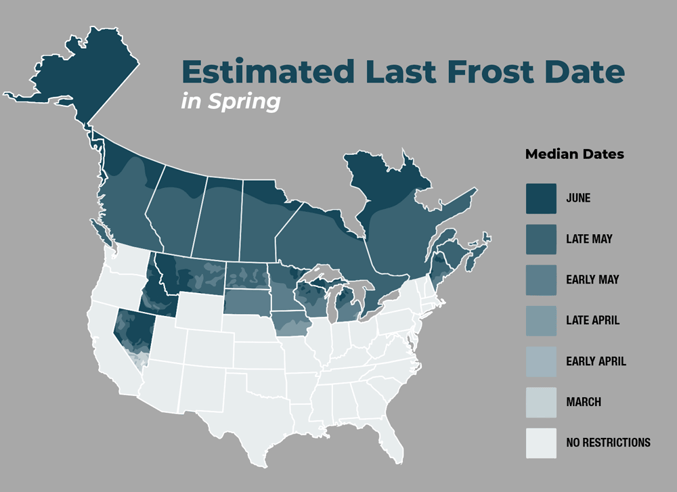As someone who's responsible for shipping and logistics, you know plenty of factors can impact your ability to transport goods from point A to point B. For example, you know that, during the treacherous winter months, blizzards and ice storms in the northernmost states may impact your schedule.
But did you know there's another factor that could impact your deliveries as winter transitions into spring?
Even after the frost subsides, something called “spring thaw” can affect the cost and timing of your shipments. And, as someone who's striving to meet customer expectations, this is more than a little frustrating.
As one of the leading over-dimensional and heavy haul carriers in North America, we've experienced many spring road ban seasons and understand the frustrations that come with them.
In this article, we'll discuss what spring thaw is, how it impacts freight shipments and what you can do to prevent spring driving conditions from negatively impacting your schedules.
How to Explain Spring Thaw to Your Customers
Throughout the winter months, prolonged periods of freezing and subzero temperatures cause roadbeds to freeze and contract.
When springtime rolls around, and temperatures start to rise well above freezing during the day, the asphalt expands and the melting ice seeps into the roadway’s foundation.
At night, temperatures drop, and the asphalt contracts once again. This daily cycle of thawing leaves roadways soft and more susceptible to cracks and breakage.

As you can imagine, large trucks with heavy loads can cause significant and expensive damage to these weakened roadways. To prevent this damage to their vulnerable roadbeds, many states, and provinces, set specific spring thaw restrictions.
The terms used to describe these restrictions — like many other terms and phrases — are called different things depending on where you are.
You may hear terms like “spring thaw,” “frost restrictions,” “thaw restrictions,” “seasonal weight restrictions,” “seasonal load restrictions” and more thrown around in reference to these restrictions — some of which can last several months.
How Do Spring Road Bans Work?
If you’re not accustomed to working with frost restrictions, it can seem complicated — especially since seasonal load restrictions are rarely consistent across state lines and international borders.
Because the restrictions vary between each state and province, you could be impacted by them even if your cargo weight is as little as 40,000 pounds. That’s right. Even legal loads can be impacted by seasonal weight restrictions.
Here’s what you need to understand:
- Some seasonal load restrictions last longer than others: There are no federal guidelines for thaw restrictions, and each jurisdiction sets its own regulations based on local climate patterns and road types. That means, in some areas, restrictions may only last six weeks, while others may last more than four months.
- Restrictions vary by region: The colder the weather, the deeper the layers that freeze — which is why you may see more restrictions in states like Minnesota or provinces like Manitoba that have particularly cold winters, but not in Ohio or Indiana, where winters are slightly milder. Also, in addition to state restrictions for interstates, local municipalities have additional or different restrictions for local road systems.
Transportation companies are beholden to these restrictions: Some frustrated organizations looking to avoid shipment delays may turn to many transportation companies in hopes they don’t have to abide by the same seasonal load restrictions. After all, you want to make sure you can meet your customers’ expectations.
Being caught with an overweight load often means paying costly fines, and/or being forced to offload or redistribute the load before you can continue.
How Can Seasonal Weight Restrictions Affect Your Shipments?
Spring thaw could leave you unable to complete your shipment at all.

Here are a few ways seasonal weight restrictions can impact shipments if you're not prepared:
- First-mile/Last-mile: Sometimes it’s not the interstates that cause the biggest challenges for transporting goods, but smaller highways and access roads at the beginning and end of the journey. Called the “first-mile” and “last-mile,” these parts of the trip may be the shortest, but create the greatest obstacles. Before a shipment leaves, it’s essential you know how it will arrive at its exact destination — down to the last few feet.
- Distance: Spring thaw can also mean shipments will take longer to deliver because drivers will need to avoid certain states or road systems. For example, a shipment from Chicago to Sioux Falls, South Dakota, may double in distance because you will have to avoid driving through Iowa or Minnesota.

What Can You Do to Overcome Seasonal Weight Restrictions?
Your customers are your top priority — and meeting their needs is essential to your ongoing success. But while spring thaw restrictions can throw a wrench in your logistics, there are a few things you can do to reduce your headaches and ensure you meet customer needs:
- Be aware and proactive: Stay informed of all of the scenarios that can come into play throughout a shipment's journey and what it might take to comply. Also, learn about some of the remedies — like distributing weight across additional axles or breaking shipments up into additional loads.
- Plan for lengthier shipment times and extra costs: When spring thaw season arrives, recognize that getting your shipments to their destination may mean waiting a while or changing up your route.
Keep Protecting Your Freight
Like other weather-based restrictions and measures, spring thaw could be out of your control. By taking the time to understand how frost restrictions impact shipping, you’ll be better prepared to make informed decisions about efforts.
